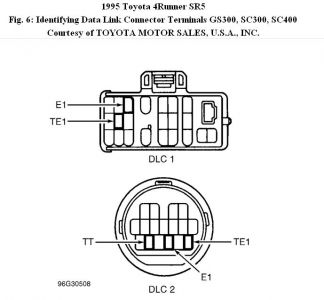Hi MonDrew,
Here are the diagnostic procedures.
NO UPSHIFT TO OVERDRIVE
1. Warm engine to normal operating temperature. With ignition off, disconnect electrical connector for solenoid from rear of transmission.
2. Road test vehicle and note if transmission upshifts to Overdrive once transmission shifts from "L" to "2" and then into "D" range. Reconnect electrical connector. Clear trouble codes from ECU memory, as disconnecting ECT ECU electrical connector may set trouble codes. If no overdrive upshift exists, transmission is defective. If overdrive upshift exists, proceed to step next step.
3. Connect voltmeter between terminals TT and E1 of data link connector. See Fig. 6 .
4. Road test vehicle and ensure voltage at terminal TT increases from zero to 7 volts. If no voltage exists, check for 12 volts between terminals "L" and E1 on ECT ECU with connector installed on ECT ECU and shift lever in "D" position with ignition on. See Fig. 11 . If 12 volts exist, check for defective park/neutral position switch or wiring circuit. If 12 volts do not exist, replace ECT ECU.
5. If voltage increases from zero to 3 volts, check for 12 volts between terminals "2" and E1 on ECT ECU with connector installed on ECT ECU and shift lever in "D" position with ignition on. If 12 volts exist, check for defective park/neutral position switch or wiring circuit. If 12 volts do not exist, replace ECT ECU.
6. If voltage increases from zero to 7 volts, transmission or solenoid is faulty. If voltage increases from zero to 5 volts, connect voltmeter between terminals OD2 and E1 on ECT ECU with connector installed on ECT ECU.
7. Turn ignition on. Check voltage with OD switch released (OFF position) and depressed (ON position). No voltage should exist with switch released and 10-14 volts with switch depressed.
8. If voltage is correct, proceed to next step. If voltage is not correct, check for defective OD switch or wiring circuit.
9. Check voltage between terminals OD1 and E1 on ECT ECU with connector installed on ECT ECU and ignition on. Voltage should be about 5 volts. If voltage is correct, replace ECT ECU. If voltage is not correct, proceed to next step.
10. Disconnect electrical connector from cruise control Electronic Control Unit (ECU). Check voltage between terminals OD1 and E1 on ECT ECU with connector installed on ECT ECU and ignition on. If voltage is now about 5 volts, replace cruise control ECU. If voltage is not about 5 volts, check for defective cruise control ECU wiring. If wiring is okay, replace ECT ECU.


Monday, November 8th, 2010 AT 11:23 AM




